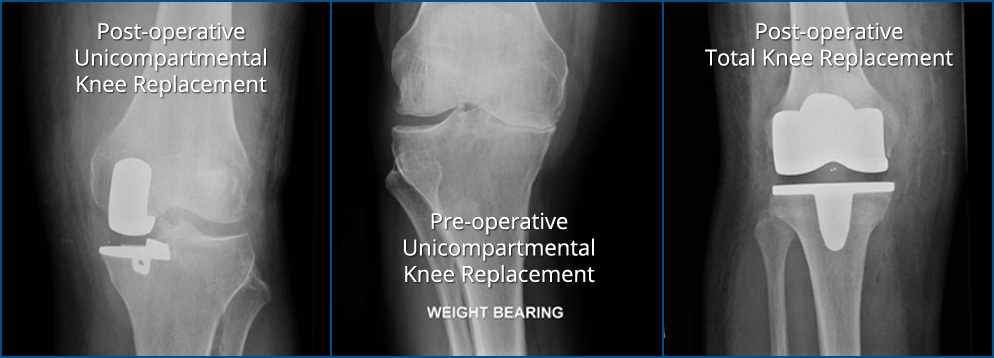KNEE REPLACEMENT SURGERY
Total Knee Replacement (TKR) became popular during the 1970’s and 1980’s as a treatment for end-stage degeneration of the knee joint. Since then, many advances have been made. Today, almost 60,000 TKRs are performed in the UK each year.
A Total Knee Replacement operation replaces the bottom end of the femur (thighbone) and the top end of the tibia (shinbone) with a prosthesis (man-made joint). Often, the patella (kneecap) must also have its back surface replaced.
There are many different knee replacements available. The majority consist of metal components that are fixed to the bottom end of the femur (femoral component) and top end of the tibia (tibial component); a plastic liner is inserted between the two. In some designs this plastic liner is mobile.
Most knee replacements are designed to be used with orthopaedic cement, which acts as a grout. Others are designed to encourage bone growth onto the prosthesis to give long term stability (uncemented).

It is the plastic liner that wears out with time, probably related to activity levels. Technological advances, however, have produced bearing surfaces which can withstand higher activity levels and will probably last much longer. For example the Genesis II™ knee replacement made by Smith & Nephew has a femoral component made of Oxinium™ which has been shown in laboratory studies to reduce the wear on the plastic liner by 90%.
Patients who are young and physically active may therefore benefit from technologies such as Oxinium™ since the risk of implant failure is significantly reduced. The surgeon should choose the most appropriate type of knee replacement for each patient.
UNICOMPARTMENTAL KNEE REPLACEMENT
Because of its anatomy, most of the weight is borne through the medial (inner) compartment of the knee. As a result, the articular cartilage on the inner side and the medial meniscus tend to wear more quickly than on the lateral side. Consequently, the knee tends to become ‘bowed’ and even more weight is borne through the medial compartment.
In time it is likely that most patients will have progression of their arthritis to the other compartments – the lateral and patello-femoral (kneecap joint). However patients who have arthritis confined to the medial compartment, and whose symptoms are uncontrolled with non-operative treatment, may be suitable for an operation to replace only this part of the knee. Replacement of only one compartment of the knee is termed a unicompartmental knee replacement.
In some cases, arthritis is confined to either the patello-femoral (kneecap) or lateral part of the knee. Unicompartmental replacement of these parts of the knee is also possible but is performed far less frequently than replacement of the medial compartment. The results are less predictable.
About 2000 unicompartmental knee replacements are performed in the UK each year. The most commonly used is the ‘Oxford Uni’ made by Biomet. It is designed to be used with cement, and consists of metal femoral and tibial components with a mobile plastic bearing in between.
A unicompartmental knee replacement is NOT a suitable treatment option for:
- Patients with inflammatory arthritis
- Obese patients
- Patients whose cruciate ligaments are not functional
- Patients with arthritis in more than one knee compartment
- Patients with marked stiffness or bowing of the knee
The benefits of a unicompartmental knee replacement compared to a total knee replacement are:
- Smaller incision and faster recovery
- Lower risk of complications
- Knee movements are ‘more normal’
- Possibly greater range of movement
Note: The long term survival of a unicompartmental knee replacement is as good as that of a total knee replacement.
Discussion with Nadim is important to answer any questions that you may have. For information about any additional conditions not featured within the site, please contact us for more information.









